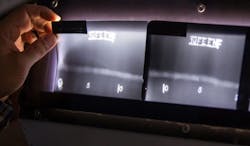DARPA asks for feasibility of nanocrystalline materials-based X-ray imaging for non-destructive testing
ARLINGTON, Va. – U.S. military researchers are asking industry determine the feasibility of a new generation of X-ray imaging technology for applications like non-destructive test and evaluation, elemental analysis, parts qualification, and high-contrast medical imaging.
Officials of the U.S. Defense Advanced Research Projects Agency (DARPA) in Arlington, Va., issued a small business innovative research (SBIR) opportunity on Monday for the Extreme Photon Imaging Capability- Hard X-ray (EPIC-HXR) project.
The EPIC-HXR seeks to develop uncooled hard X-ray imagers based on advanced nanocrystalline materials with high spatial and energy resolution at a Technology Readiness Level (TRL) of 5, which means that components can be validated in simulated or real-space environment.
Nanocrystalline materials include quantum dot and perovskite material systems, which have generated interest because of their properties such as tunable bandgap energies, quantum confinement, multi-exciton generation, and phonon quenching.
Such materials hold promise as high-performance photon absorbers able to operate at room temperature and can be tailored to the hard X-ray region of the electromagnetic spectrum for applications like non-destructive testing and high-contrast medical imaging.
In addition, these materials often are amenable to solution processing to enable production of low-cost imagers with small pixel sizes by avoiding hybridization with complementary metal oxide semiconductor (CMOS) or emerging indium gallium zinc oxide (IGZO) readout circuitry.
Still, challenges like poor charge transport, limited scalability of assembly processes, limited lifetimes or poor stability remain before such materials can help produce practical devices, DARPA researchers point out.
From room-temperature nanocrystalline hard X-ray imagers, researchers want energy resolution of less than 2 percent; spatial resolution of less than 55 microns; energy range of 5 to 300 kilo-electron volts (keV); area larger than 30 by 30 centimeters; and absorption equivalence of less than 50 percent stopping power.
Phase-one of the EPIC-HXR project a feasibility study that should demonstrate the scientific, technical, and commercial merit and feasibility of a basic device design and credible process flow.
Activities could include device modeling, materials modeling, basic material synthesis, assembly experiments, characterization, and identification of Key requirements for materials and interfaces. The project also should identify the technical challenges of scaling the absorbing material to size and thickness.
Companies interested should submit proposals no later than 28 Sept. 2021 online at www.sbir.gov/content/submission-proposals. Email questions or concerns to [email protected], with BAA HR001121S0007-21 in the subject line.
More information is online at https://sam.gov/opp/d1816a9e3b4a476aa07247c02f899411/view.
About the Author
John Keller
Editor-in-Chief
John Keller is the Editor-in-Chief, Military & Aerospace Electronics Magazine--provides extensive coverage and analysis of enabling electronics and optoelectronic technologies in military, space and commercial aviation applications. John has been a member of the Military & Aerospace Electronics staff since 1989 and chief editor since 1995.
